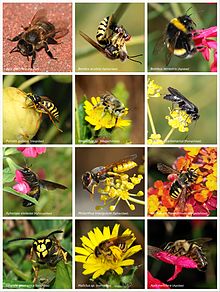Haplodiploidy
Haplodiploidy is a sex determination system in which males develop from unfertilized eggs and are haploid, and females develop from fertilized eggs and are diploid.[1]

Haplodiploidy determines the sex in all members of the insect order Hymenoptera (bees, ants, and wasps), and the Thysanoptera ('thrips').[2]p408[3] The system also occurs sporadically in some spider mites, coleopterans (bark beetles) and rotifers.
In this system, sex is determined by the number of sets of chromosomes an individual receives. An offspring formed from the union of a sperm and an egg develops as a female, and an unfertilized egg develops as a male. This means that the males have half the number of chromosomes that a female has, and are haploid.
The haplodiploid sex-determination system has a number of peculiarities. Most importantly, the relatedness between the sisterhood of worker bees in a hive or nest is 0.75. This means the workers are significantly more closely related than siblings in other sex determination systems.[4] It is this point which drives the kin selection theory of how eusociality evolved.[2]p465[5] Whether haplodiploidy did in fact pave the way for the evolution of eusociality is still a matter of debate.[6][7]
The thing to remember is that in normal sexual reproduction, the father has two sets of chromosomes, and crossing over takes place between the chromatids of each pair during the meiosis which produces the sperm. Therefore, the sperms are not identical, because in each chromosome of a pair there will be different alleles at many of the loci. But when the father is haploid all the sperm will be identical (except for a small number where gene mutations have taken place in the germline). So, as long as all the female queen mates only with one male, all the female offspring will inherit the male's chromosome 100% intact. In fact in Hymenoptera, the males almost all produce enough sperm to last the female for a whole lifetime.[5]
Another feature of the haplodiploidy system is that lethal and deleterious alleles will be removed from the population rapidly because they will automatically be expressed in the males.[3]
References
change- ↑ King R.C; Stansfield W.D. and Mulligan P.K. 2006. A dictionary of genetics. 7th ed, Oxford University Press, p194. ISBN 0-19-530761-5
- ↑ 2.0 2.1 Grimaldi D. and Engel M.S. 2005. The evolution of the insects. Cambridge University Press. ISBN 0-521-82149-5
- ↑ 3.0 3.1 White, Michael J.D. (January 1984). "Chromosomal Mechanisms in Animal Reproduction". Bolletino di Zoologia. 51 (1–2): 1–23. doi:10.1080/11250008409439455. ISSN 0373-4137.
- ↑ The relatedness of siblings in most other systems is 0.5.
- ↑ 5.0 5.1 Hamilton W.D. 1964. The genetical evolution of social behaviour, I and II. Journal of Theoretical Biology 7, 1–52. Reprinted with comments in Hamilton W.D. 1996. Narrow roads of geneland, volume I Evolution of social behaviour. Freeman/Spektrum, Oxford. ISBN 0-7167-4530-5
- ↑ Hughes W.O.H.; et al. (2008). "Ancestral monogamy shows kin selection is key to the evolution of eusociality". Science. 320 (5880): 1213–1216. Bibcode:2008Sci...320.1213H. doi:10.1126/science.1156108. PMID 18511689. S2CID 20388889. Retrieved 2008-08-04.
- ↑ Wilson, Edward O. (2005). "Kin selection as the key to altruism: its rise and fall". Social Research. 72: 159–166. doi:10.1353/sor.2005.0012. S2CID 142713581. Archived from the original (PDF) on 2012-10-23. Retrieved 2011-03-25.